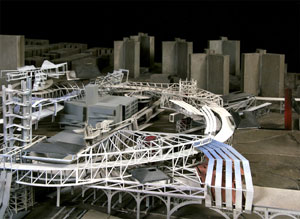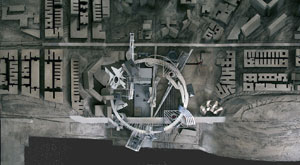by: Jessica Sheridan Assoc. AIA LEED AP
After studying the 19.7-acre Manhattanville design conceived by Renzo Piano Building Workshop with master planning by Skidmore, Owings & Merrill, fourth-year design students at The Cooper Union’s Irwin S. Chanin School of Architecture were asked to re-analyze the site and design an alternative master plan. Throughout the semester, they researched it’s topography, history, and sociological character, and collaboratively fabricated a scaled site model to test their designs.
e-Oculus had the opportunity to sit down with Professor Lebbeus Woods, Adjunct Professor Christoph a. Kumpusch, and students Christopher M. Pounds, Anna Kostreva, Raye C. Levine, Dennis Murphy, and Tom Brooksbank to discuss their projects.
e-Oculus: Why did you choose the Manhattanville site, and how was the studio organized to develop the program?
Lebbeus Woods: We picked a site that Columbia University is trying to expand into over the next 25 years, and we used it as an opportunity to imagine what a 21st century campus might be like. It’s not a critique of the Columbia plan; it’s really an independent piece of research. So we’ve taken a master planning approach, and we decided to adopt a matrix idea.
During the first part of the semester, we held an in-studio competition. There were seven teams of four students each. Each team proposed their matrix. We had a distinguished jury, which included Steven Holl, AIA, Diana Agrest, FAIA, Michael Bell, and several faculty members, and they chose what they felt was the best matrix, which is the one we developed. The reason they thought it was best was because it was based on the idea of movement on and above the site, connecting different existing levels. This scheme took advantage the site’s verticality — the elevated train and subway to the east, the highway to the west, plus the general topography which has a hilly quality to it.
Then, the rest of the semester was spent developing concepts or programs that can plug into the matrix. So the overall landscape can be looked at as an evolving landscape, because the idea a 21st century institution for education is something that evolves. It’s a living, organic structure.










